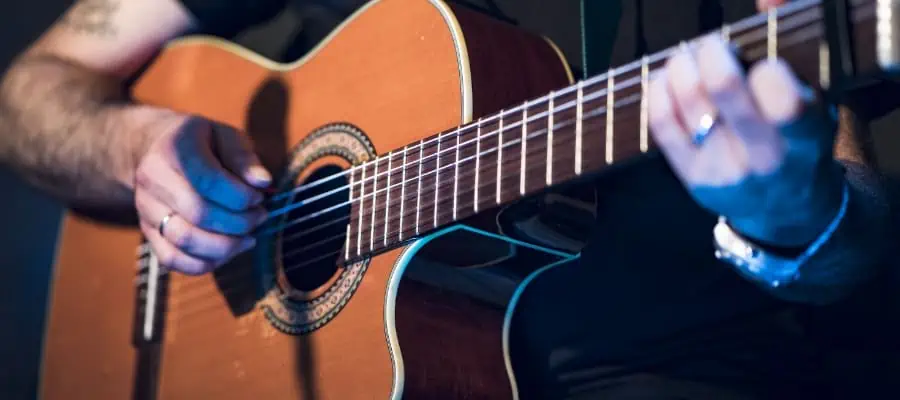Cutaways refer to a section of the guitar’s body where the upper part of the side is removed, allowing easier access to the frets on the instrument’s neck. Though this practical feature has started to gain popularity among a wide array of guitar manufacturers, those catering to the classical crowd seem to stay away from it. So, why is that – can classical guitars have cutaways?
Classical guitars can have cutaways; however, that’s not the norm, especially among more traditional guitarists. That’s because, historically, classical guitars are made with wide, rounded bodies that don’t provide easy access to the higher frets, and adding a cutaway changes their tonal qualities. Classical guitars always come with a more traditional approach, and luthiers want to keep it that way, giving importance to historical features like body shape and aesthetical considerations.
You might be wondering – wouldn’t adding a cutaway to a classical guitar provide easier access to the frets and, thus, make the playing experience easier? So, how come the feature never really took off among these musicians? You’ll find the answers to these questions and more below, so make sure to read on.
Why Most Classical Guitars Don’t Have Cutaways

If you’ve ever seen a classical guitar before, you know that these instruments boast a signature rounded body shape that’s been used for centuries. This design is often praised for its ability to produce a warm, full-bodied tone that’s ideal for the genre.
The traditional build of a classical guitar puts more emphasis on the resulting sound rather than playability or practicality. That’s why cutaways are rarely included in these kinds of guitars, which are widely viewed as a practical addition to any instrument.
Instead, they’re more commonly found on steel-string acoustic and electric guitars, where the design aims to emphasize playability and facilitate access to the upper frets. However, since classical guitar music is generally played in the lower positions of the neck, this type of increased access isn’t always necessary.
Moreover, classical guitarists generally use a different technique than their peers, anchoring their thumb on the back of the guitar’s neck, allowing them to easily access the higher frets without needing a cutaway.
What’s more, the classical guitar-playing crowd tends to be a bit conservative in its approaches, and it’s very rare for players to sway from traditional instruments, shapes, and techniques. For example, classical guitars do not have inlay dots to navigate through the fretboard easier for players. This is also because of the traditional approach, just like the cutaway-less design.
Though some might consider this level of perseverance overkill, it’s important to note that the whole character of the genre relies on the warm, smooth sound and tonal quality that these guitars produce.
Adding a cutaway will affect both features, leading to an undesirable classical guitar that has lost its prized tonal quality. That’s why, even today, you’ll rarely find classical guitars with cutaways, especially among older, more traditional musicians.
Musicians aren’t the only ones taking a stance against modern variations of their beloved traditional guitars, as audiences of the genre also favor more classical models that produce the type of sound they’ve grown to know and love.
With all that said, you may still find some modern variations that include this feature; just be prepared to sacrifice some of that rich, full-bodied sound that classical guitars are known for.
One compromise some modern classical guitarists have been able to rely on is the inclusion of a raised fingerboard. This slight change still allows the instrument to retain its traditional look and sound while providing better access to the higher fretboards so that the guitarist can perform more easily.
Lastly, I want to note that though a cutaway is generally considered a practical addition to any guitar, that might not always be true. When someone’s used to playing without it for their entire career, suddenly having to work with one will just make the playing experience feel unnecessarily complex.
And since most classical guitar players already have years of experience, you can understand their apprehension when dealing with such a non-traditional feature.
Throughout this section, I’ve repeatedly mentioned that a cutaway can significantly affect the tone and playability of a classical guitar. So, let’s expand on that a bit more.
How Does a Cutaway Affect a Classical Guitar?

If, after reading the arguments outlined above, you’re still unsure why classical guitar players remain so adamant about not including cutaways in their instruments, it’s time to take a deeper look at how much this feature can affect these types of instruments.
In terms of playability, a cutaway will make it easier to reach the higher frets, which can be especially helpful for musicians of genres that require more intricate fingerwork. However, it can also change how a guitar feels when you’re playing it in the lower positions, which is the most common style among classical guitarists.
Since these musicians tend to focus on the lower side of the neck, adding a cutaway to their guitars wouldn’t provide enough advantages to justify the change in sound and tone quality.
Speaking of tone, the traditional classic guitar body shape is essential to the sound it produces. It emphasizes a warm, full-bodied experience that could be affected by adding a cutaway. As the sound vibrations get amplified in the soundhole, changing the shape of the body directly affects this amplification. The volume and projection of the instrument would also be degraded as a result.
With all that said, it’s important to note that modern manufacturing techniques have made it possible to create cutaway classical guitars that still preserve the traditional tonal qualities of the instrument. That’s why there seems to be a slight shift in how newer classical guitarists interpret the genre, and more cutaway instruments can be expected to be used in the future.
Conclusion
Though classical guitars can have cutaways, most classical musicians prefer to make do without them. That’s because adding this feature can affect the signature sound and tone classical guitars are known for without adding much in terms of playability since most techniques these musicians rely on don’t involve access to the upper frets.
What’s more, performers and audiences of classical guitar tend to put a lot of value in tradition, so even the slightest change in body shape and sound won’t be appreciated. However, newer classical guitarists are more open to well-made cutaway guitars.
If you found this article useful, you may want to save this pin below to your Guitar board.

Recent Posts
Some guitarists insist on buying an expensive amplifier with their electric guitar. They assume that this is a must for every type of guitarist out there. However, in some situations, this isn’t...
Top 50 Free Realistic Guitar VST Plugins With Sound Examples
As technology has rapidly advanced in the recent decade, computers are stealing more and more roles from physical musical instruments and accessories. Nowadays, you do not need expensive amps,...

